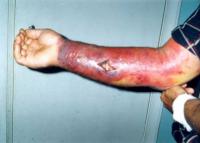-
Senate approves $1.1 billion to fight Zika virus
The Senate on Tuesday voted 68-29 to allocate $1.1 billion in emergency funding to fight the Zia virus threat. The funds fall short of the White House’s request of $1.9 billion, but are significantly more than House Republicans’ $622 million anti-Zika proposal. The House will debate the measure on Wednesday.
-
-
Maryland identifies health vulnerabilities resulting from climate change
As world leaders convened in Washington, D.C. a couple of weeks ago for the Climate Action 2016 summit, a new report by Maryland public health leaders details the impacts of climate change on the health of Marylanders now and in the future. The report examines the relationship between exposure to extreme weather events and risk of selected health outcomes including food and waterborne illnesses, hospitalization for heart attacks and asthma, and motor vehicle accidents.
-
-
NSF awards $1.7 million in rapid response grants to study Zika virus
Zika, discovered in Uganda in 1947, has been documented since the 1950s along the equatorial belt from Africa to Asia. In 2014, the virus spread eastward to French Polynesia, and in 2015 to Mexico, Central America, the Caribbean (including Puerto Rico) and South America, where the outbreak continues. To find new ways of halting the spread of Zika — fast becoming a major public health threat — the National Science Foundation (NSF) Division of Environmental Biology’s Ecology and Evolution of Infectious Diseases (EEID) Program has funded nine rapid response, or RAPID, grants totaling $1.7 million.
-
-
A new paper-based test for the Zika virus
A new paper-based test developed at MIT and other institutions can diagnose Zika virus infection within a few hours. The test, which distinguishes Zika from the very similar dengue virus, can be stored at room temperature and read with a simple electronic reader, making it potentially practical for widespread use.
-
-
Israeli tech ready to take on Zika-carrying mosquito
The mosquito-borne Zika virus, according to new reports, is even more dangerous than first believed. While better information about prevention has helped slow the rate of infection in some areas, the health community is still urgently searching for a vaccine or drug treatment. The world seeks a medical intervention, but Biofeed’s no-spray green product targets the insects directly.
-
-
Developing new anthrax vaccine

The Texas A&M Center for Innovation in Advanced Development and Manufacturing (CIADM) will produce an intranasal anthrax vaccine candidate under a task order issued by the U.S. Department of Health and Human Services (HHS). This is the first task order issued to the Texas A&M center and will enhance protection from anthrax disease. The Texas A&M facility is one of three CIADMs — and the only academically-based center — established as public-private partnerships with BARDA in 2012 to enhance the nation’s emergency preparedness against emerging infectious diseases.
-
-
The long history of lead poisoning in the U.S.
While state and federal officials continue to criticize each other for failing to guarantee safe drinking water, the question of exactly who is responsible for crises like in Flint, Michigan, lies at the root of the problem. “The crisis in Flint brought the true costs of a neglected infrastructure to the nation’s attention, but in the finger-pointing there are deeper debates over public and private responsibility and the impact of dysfunctional politics on public health,” says one expert.
-
-
Floods, coastal erosion may expose contents of UK landfills
The contents of historic coastal landfill sites in England and Wales could pose a significant environmental threat if they erode, according to a new study. The main risks to these landfills come from the effects of climate change, including erosion and flooding with salt water from storm surges and higher water levels.
-
-
Measuring electromagnetic radiation exposure
Society demands continuous implementation of new transmission systems due to ongoing development of communication technologies. These systems work by emitting electromagnetic waves. As a result, population is exposed to a significant increase of environmental radiation levels. Researchers from UPM have developed a portable device that allows continuous monitoring the exposure levels to electromagnetic radiations of a person who wears such device.
-
-
New drug to combat the effects of nerve agents
Sarin is a colorless, odorless liquid fatal even at very low concentrations. Serious sarin poisoning causes visual disturbance, vomiting, breathing difficulties and, finally, death. A ground-breaking study describes the development of a new drug which counteracts the effects of sarin gas.
-
-
More corrosion-resistant water pipes could preventing another Flint, Mich. health crisis
Corrosion-related damage costs more than three percent of the United States’ Gross Domestic Product (about $503.1 billion, going by 2013 numbers). With documented public water problems in Flint, Michigan, and Hoosick Falls, New York, caused by corrosion, understanding how copper is affected at the atomic level is critical to avoiding problems in future pipes.
-
-
Illegal mining in Colombia linked to malaria outbreak
The Colombian National Health Institute recorded 18,524 malaria cases in 2015. The year before, only 4,730 malaria cases were recorded. The sharp increase in the number of malaria cases in different areas of Colombia has been linked to illegal open-cast mining. Stagnant water and poor sanitary conditions have been discovered at these often hidden rural locations.
-
-
Cellphone-sized device detects the Ebola virus quickly

The worst of the recent Ebola epidemic is over, but the threat of future outbreaks lingers. Monitoring the virus requires laboratories with trained personnel, which limits how rapidly tests can be done. Now scientists report in ACS’ journal Analytical Chemistry a handheld instrument that detects Ebola quickly and could be used in remote locations.
-
-
What we learned from Chernobyl about how radiation affects our bodies
The world has never seen a nuclear accident as severe as the one that unfolded when a reactor exploded in Chernobyl on 26 April 1986, sending vast amounts of radiation into the skies around Ukraine, Belarus and Russia. The planet had experienced massive releases like this before, in the bombings of Hiroshima and Nagasaki in 1945. But Chernobyl-related radiation exposure had a more protracted character. It was the first time in history that such a large population, particularly at a very young age, was exposed to radioactive isotopes, namely iodine-131 and cesium-137, not just through direct exposure, but through eating contaminated food as well.
-
-
The legacy of Chernobyl -- 30 years on
The 26 April 2016 marks the 30th anniversary of the Chernobyl nuclear accident. For many, especially those born since 1986, it is a word they know without appreciating the full significance of what happened on that day. For others, it was a life changing catastrophe which resulted in largest release of radioactivity in the history of nuclear energy.
-
More headlines
The long view
Ransomware Attacks: Death Threats, Endangered Patients and Millions of Dollars in Damages
A ransomware attack on Change Healthcare, a company that processes 15 billion health care transactions annually and deals with 1 in 3 patient records in the United States, is continuing to cause massive disruptions nearly three weeks later. The incident, which started on February 21, has been called the “most significant cyberattack on the U.S. health care system” by the American Hospital Association. It is just the latest example of an increasing trend.
